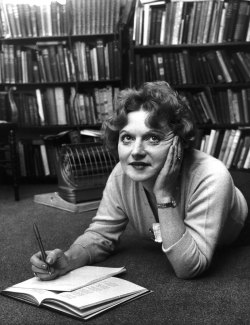The Political Warfare Executive – what’s in a (cover) name?
Principal Investigator James Smith on Whitehall secrecy and the names used to conceal PWE operations
One of the initial issues that this project faces is that, while a range of authors and intellectuals had some sort of connection to the Political Warfare Executive during the war, you would be hard pressed to find direct mention of the name ‘PWE’ in many of their memoirs or biographical accounts. Take, for example, the way that Muriel Spark’s autobiography Curriculum Vitae (1992) describes her service:
I played a very small part, but as a fly on the wall I took in a whole world of method and intrigue in the dark field of Black Propaganda or Psychological Warfare, and the successful and purposeful deceit of the enemy. […] The Foreign Office secret intelligence service was MI6, of which our department was Political Intelligence.

We know that Spark worked for the PWE’s black broadcasting unit in Woburn under Sefton Delmer, but her account here shows just how convoluted later descriptions of the PWE can become. For one, MI6 and Delmer’s unit were quite separate organisations, so the lines of command she lists here are unclear – is Spark simply confused, repeating her genuine understanding, or hitching her obscure secret work on to the better-known status of MI6? And the reference to the Political Intelligence Department (PID) of the Foreign Office is one of the most common ways PWE employees characterised their roles, but this was the result of a deliberate policy of obscuring the true existence of the PWE as a dedicated covert propaganda apparatus.
As a secret note circulated across Whitehall upon the founding of the PWE specified, ‘Since PWE is a secret department, the cover will continue to be the Political Intelligence Department of the Foreign Office’, with ‘all questions and communications’ with the outside world about its propaganda being routed through the cover address of ‘The Secretary, Political Intelligence Department of the Foreign Office, 2 Fitzmaurice Place, Berkeley Square, W1’.[1] This became entrenched, and many of the documents and references concerning the PWE automatically refer to the ‘PID’ – Spark’s repetition of this, decades after the war, suggests the extent to which this cover had become ingrained as the natural name for her employer.
And the same secrecy (not to mention the opaque and complex bureaucratic structures of wartime Britain) means that many of those temporary recruits involved in some aspect of the PWE’s work probably only had a tiny glimpse of the wider propaganda organ they were working within. Those authors working in the PWE’s Editorial Unit in London to develop magazines to send to liberated Europe, for example, probably had little sense of those working on the deception campaigns being developed in Woburn (‘the Country’, as it became mysteriously known to London staff), and in turn those doing broadcasts on the BBC’s European Service under PWE oversight probably had little idea about how their particular cog fitted into this broader machine.
So, untangling these different names, cover identities, and ambiguous affiliations will be a significant objective for the project – and one that will, we hope, leave us with a far clearer picture of the PWE’s cultural networks during the war.
Note
[1] This note is in FO 898/10. Ellic Howe, The Black Game (Queen Anne Press, 1988), provides some broader details about this evolution of the PWE at this time and the relationship of the PWE to the ‘real’ PID – a department concerned with composing information summaries and offering ‘genteel employment’ to ex-ambassadors that suddenly found its names being used as cover for this separate operation. See pp. 41-53.
